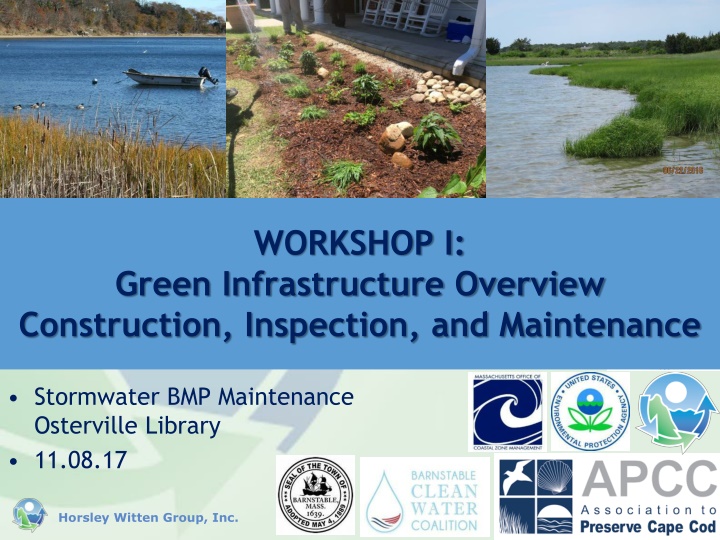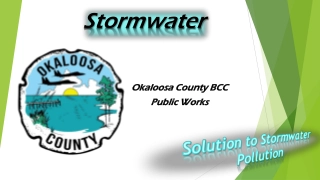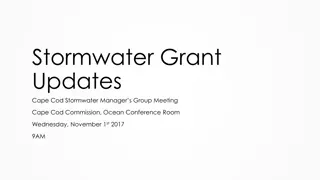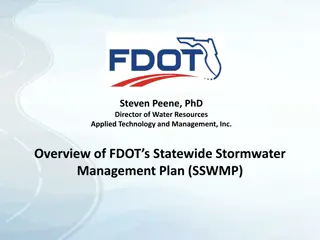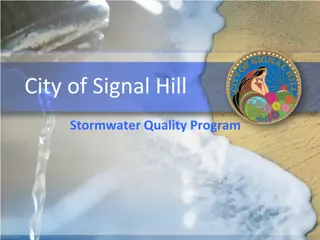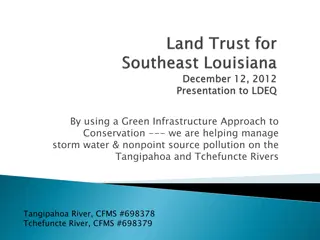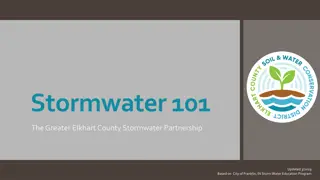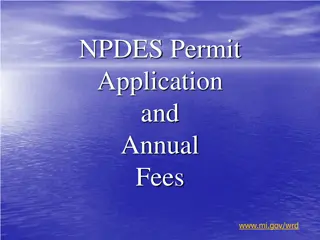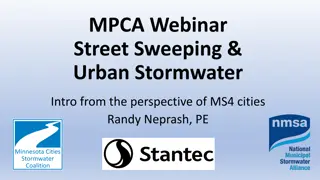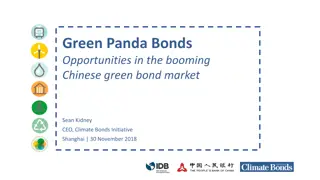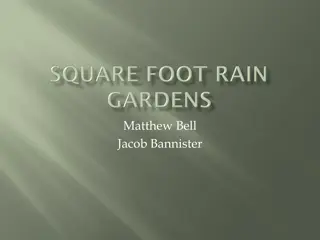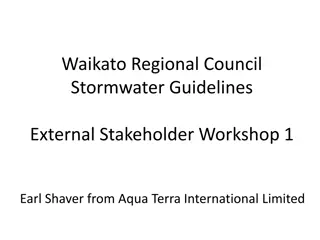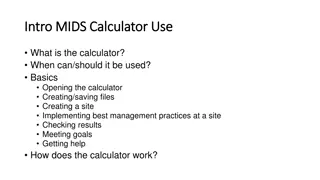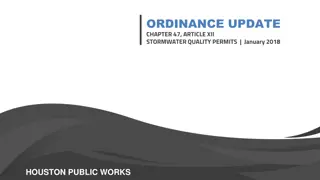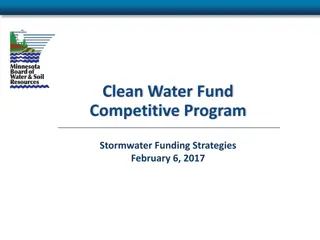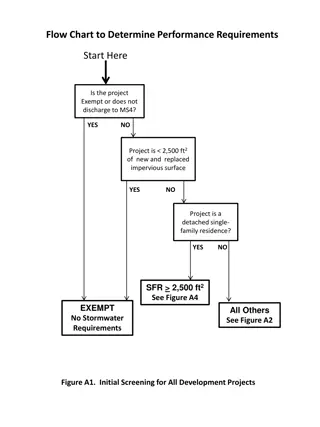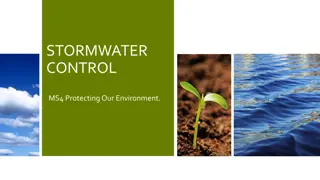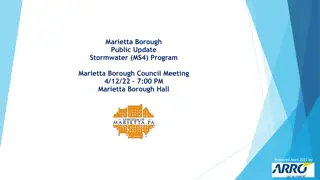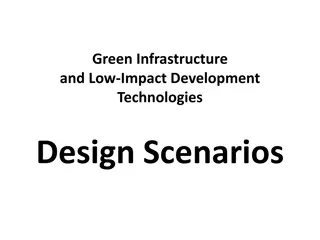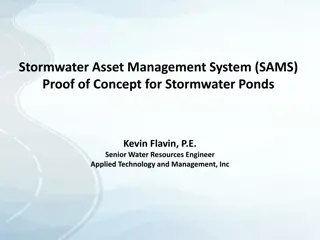Green Infrastructure: Sustainable Stormwater Management Workshop
Explore the importance and benefits of green infrastructure for managing stormwater runoff, reducing environmental impacts, and promoting sustainable practices. Learn about bioretention systems, comparison with traditional methods, and the positive effects on water, energy, and air quality. Discover how green infrastructure mimics natural processes to protect the environment and communities.
Download Presentation

Please find below an Image/Link to download the presentation.
The content on the website is provided AS IS for your information and personal use only. It may not be sold, licensed, or shared on other websites without obtaining consent from the author.If you encounter any issues during the download, it is possible that the publisher has removed the file from their server.
You are allowed to download the files provided on this website for personal or commercial use, subject to the condition that they are used lawfully. All files are the property of their respective owners.
The content on the website is provided AS IS for your information and personal use only. It may not be sold, licensed, or shared on other websites without obtaining consent from the author.
E N D
Presentation Transcript
WORKSHOP I: Green Infrastructure Overview Construction, Inspection, and Maintenance Stormwater BMP Maintenance Osterville Library 11.08.17 Horsley Witten Group, Inc.
PRESENTATION OUTLINE 8:15 - 8:45 Why Green Infrastructure (GI) Overview of GI BMPs and how they work Comparison of GI to traditional practices (will cover this as we go) Green Infrastructure Practice Overview Bioretention at Heritage Museum and Gardens, Sandwich, MA Horsley Witten Group, Inc.
Many Cape Estuaries Impaired by Excess Nitrogen and Bacteria Horsley Witten Group, Inc.
Negative Effects on the Environment and Community Algal blooms from excessive nutrient delivery; loss of aquatic grasses (eelgrass); low dissolved oxygen; and fish kills Impacts human uses (swimming, boating, fishing); aesthetics; and property values Horsley Witten Group, Inc.
What is Green Infrastructure? An approach to land development/ redevelopment that mimics nature in managing stormwater runoff A term that is used differently by different disciplines and in different contexts GI / GSI / LID Stormwater practices that infiltrate, evaporate, or harvest and re-use stormwater runoff as close to its source as possible Uses soils, shallow depressions, and vegetation to minimize runoff and closely reflect natural conditions Horsley Witten Group, Inc.
Green Infrastructure Principles Treats stormwater as a resource Preserves and/or recreates natural landscape features Minimizes the effects of impervious cover Implements stormwater practices that rely on natural systems to manage runoff Bioretention at HYA, Hyannis, MA Horsley Witten Group, Inc.
Green Infrastructure Benefits WATER Runoff volume & flooding reduction Natural recharge to groundwater Pollutant reduction and cleaner water ENERGY Reduced urban heat island effect Less energy used for cooling AIR QUALITY Natural uptake of pollutants from air Bioretention at BSU, Bridgewater, MA Horsley Witten Group, Inc.
Green Infrastructure Benefits COMMUNITY AND HABITAT Increased wildlife habitat More recreational space Increased property values Increased public awareness COSTS Reduced landscaping costs Less wastewater treatment costs Less life-cycle costs REGULATORY COMPLIANCE Compliant with permit requirements Before After Mill River Park Taunton, MA Horsley Witten Group, Inc.
Traditional vs Green Infrastructure Traditional controls GI controls Goal: Reduce the amount of surface runoff by reducing impervious cover and preserving natural areas Goal: Convey runoff & meet regulatory requirements Collect and storage in big, hole in ground off-site Rely on small, distributed, surface vegetated practices Pipe discharge to a pond or proprietary device Infiltrate or reuse as much as possible; filter before discharge Limited water quality treatment and infiltration Stormwater management is an afterthought Source controls to minimize pollution Stormwater is a resource Horsley Witten Group, Inc.
Tradition vs GI Detention Pond Surface GI Retention Pond Horsley Witten Group, Inc.
GREEN INFRASTRUCTURE PRACTICES Bioretention and Green Street Practices Permeable/Porous/Pervious Pavements Infiltration Practices Swales and Channels Constructed Wetlands Rainwater Harvesting Green and Blue Roofs Non-Structural Practices Horsley Witten Group, Inc.
Bioretention and Green Streets Shallow landscaped depression designed to capture stormwater runoff for treatment and/or infiltration through natural processes. Practice Variants: Bioretention Tree Filters Stormwater Planters Rain Gardens Horsley Witten Group, Inc.
Bioretention Schematic Runoff Vegetation on Surface Planting Soil - Primarily Sand Underdrain System Horsley Witten Group, Inc.
Bioretention at Steamship Auth, Palmer Ave, Falmouth, MA Horsley Witten Group, Inc.
Bioretention Benefits Benefits: Versatile practice Runoff reduction, promotes recharge Good pollutant removal (> 80% of sediment) Aesthetics (combine with site landscaping) Modest space consumption Natural approach, affecting air quality, temperature, & habitat Horsley Witten Group, Inc.
Permeable/Porous/Pervious Pavements Practice Variants: Permeable pavers Porous asphalt Pervious concrete Proprietary materials (pre-cast pervious slabs, recycled tires/glass) Permeable surface material that allows rainfall to percolate through the media into underlying soils or drainage collection system. Horsley Witten Group, Inc.
Permeable Paver Options Horsley Witten Group, Inc.
Infiltration Stormwater control practices designed to infiltrate runoff into the underlying soils and ultimately recharge the groundwater. Practice Variants: Infiltration basins Infiltration trenches Underground chambers Dry wells Horsley Witten Group, Inc.
Permeable Pvmt/Infiltration Benefits Benefits: Versatile practices Runoff reduction, promotes recharge Excellent pollutant removal (> 90% of sediment) Aesthetics (combine with site landscaping) Modest space consumption Possible to manage a range of storms from small to large Buckman Heights courtyard with infiltration garden Horsley Witten Group, Inc.
Swales and Open Channels Removes pollutants through particle settling and filtration. Infiltration typically occurs as water flows across the surface. Compost amendments can increase infiltration and water storage, and improve plant health. Design variants: Dry swale, wet swale, bioswale, grass channel Horsley Witten Group, Inc.
Swales and Open Channels Bioswale at Heritage Museum & Gardens, Sandwich, MA Bioswale , New York, NY Horsley Witten Group, Inc.
Swale/Channel Benefits Benefits: Linear practice (good for roads/highways) Runoff reduction, can promotes recharge Mixed pollutant removal (possible bacteria source birds/pets/other wildlife) Aesthetics (combine with site landscaping) Modest space consumption Best in flatter slopes; design variants allow for use in places with high gw/poor soils Wet Swale at Roger Williams Park, Providence, RI Horsley Witten Group, Inc.
Constructed Stormwater Wetlands Design variants: Shallow Marsh Wetland (aka, surface wetland) Ext. det. Wetland Gravel Wetland Wet Swale Wet vegetated treatment systems incorporating natural wetland elements Combines detention and retention elements that can manage a wide range of storm events (WQ to Q100) Const. Wetland at Scouting Way, Peabody, MA Horsley Witten Group, Inc.
Constructed Stormwater Wetland Benefits Benefits: Can manage a range of storms (WQ to 100 yr) Versatile practice; good in high gw conditions Good pollutant removal (especially nitrogen) Natural Aesthetics and provides wildlife habitat Lower maintenance Typically more cost effective than smaller on-site GI Gravel Wetland at Maine Mall, S. Portland, ME Horsley Witten Group, Inc.
Constructed Stormwater Wetlands During construction Five years after construction WVTS in Chepachet Village, Glocester, RI Horsley Witten Group, Inc.
Mashpee Commons Mashpee, MA Horsley Witten Group, Inc.
Mashpee Commons Opportunities Horsley Witten Group, Inc.
Highpoint, Seattle, WA SvR Design StormTree, Providence, RI Horsley Witten Group, Inc.
A Few Challenges to GI Contaminated soils Avoid excavation and infiltration in contaminated soils Areas with high potential pollutant load or discharges to sensitive resources (e.g., Zone II) Infiltration prohibited or higher pretreatment standards Class V well registration Infiltration practices that are deeper than they are wide Conflicts with local development codes Subdivision rules may require curbs, two sidewalks, wide roads, stormwater catch basins and pipes, and prescribed street trees, which all can limit flexibility for GI Horsley Witten Group, Inc.
In Summary. Green Infrastructure is a useful tool for maintaining, mimicking and restoring natural hydrology and protecting water quality in the developed landscape. It is flexible, effective, and achieves multiple other benefits. Horsley Witten Group, Inc.
